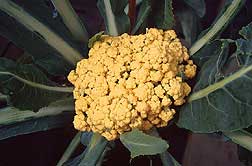ARS News Service
Agricultural Research Service, USDA
Hank Becker, (301) 504-1624, hbecker@asrr.arsusda.gov
July 7, 1999
 An orange cauliflower plant, found
growing in a Canadian field nearly 30 years ago, could provide important genetic clues for
boosting the nutritional value of many different crops. The mutant cauliflower produces so
much beta-carotene--an orange pigment in carrots and other fruits and An orange cauliflower plant, found
growing in a Canadian field nearly 30 years ago, could provide important genetic clues for
boosting the nutritional value of many different crops. The mutant cauliflower produces so
much beta-carotene--an orange pigment in carrots and other fruits and
vegetables--that normally white parts of the plant turn orange.
Beta-carotene belongs to a class of compounds known as carotenoids, important to human
nutrition.
Plant molecular biologist David F. Garvin at the Agricultural Research Service is studying
the mutant cauliflower as a model for unraveling the biochemical and molecular basis of
carotenoid production in crops. Chemical analyses indicate beta-carotene concentrations in
some tissues of the mutant are several-hundred-fold higher than normal cauliflower,
according to Garvin at the U.S. Plant, Soil and Nutrition Laboratory in Ithaca, N.Y. The
lab is part of ARS, USDA's chief research agency.
Beta-carotene has antioxidant properties that may reduce the incidence of cardiovascular
disease and certain types of cancer. It's also an important source of vitamin A. But many
crops important to human diets contain little or no beta-carotene. Garvin hopes the
research will ultimately provide
information needed to genetically engineer increased carotenoid content in important crops
like wheat and rice that lack the compounds.
Various characteristics of the mutant have led Garvin to postulate that an altered gene in
it may act as an important switch for turning carotenoid production on or off. The
programming error, according to Garvin, is due to an alteration in one gene. His
preliminary molecular studies suggest this gene alteration may influence other genes
required for synthesizing beta-carotene. A story about the mutant cauliflower appears in
the July issue of Agricultural Research magazine and on the web at http://www.ars.usda.gov/is/AR/archive/jul99/cauli0799.htm
Scientific contact:
David F. Garvin
ARS U.S. Plant, Soil and Nutrition Laboratory, Ithaca, N.Y., phone (607) 255-7308,
fax (607) 255-1132, dfg3@cornell.edu.
Coliflor
anaranjado podrá ayudar cientificos aumentar nutrición
Servicio Noticiero del Servicio de Investigación Agrícola (ARS siglas en inglés)
Departamento de Agricultura (USDA siglas en ingles)
Hank Becker, (301) 504-1624, hbecker@asrr.arsusda.gov
7 de julio 1999
Una planta de coliflor anaranjado, encontrado en un campo de Canada hace casi 30 años,
podrá proveer una pista para aumentar el valor de varias siembras diferentes. El coliflor
mutante produce tanto beta-caroteno, que las partes de la planta que normalmente están
blancas, se cambian al
color naranja. El beta-caroteno es el pigmento anaranjado en la zanahoria.
El beta-caroteno pertenece a una clase de compuestos conocidos como
"carotenoides," los cuales son importantes a la nutrición humana.
Biológo molecular de plantas David F. Garvin del Servicio de Investigación Agrícola
(ARS siglas en inglés) está estudiando el coliflor mutante como un modelo para
desenredar la base bioquímica y molecular de la producción del carotenoide en las
siembras. Análisis químicos indican que las concentraciónes de beta-caroteno en algunos
tejidos del coliflor mutante son
más altos que en el coliflor normal, según Garvin, del Laboratorio de Plantas, Tierra y
Nutrición en Ithaca, New York. El laboratorio es parte de ARS, cual es la agencia
principal de investigación del Departamento de Agricultura.
El beta-caroteno tiene propiedades que reducen la incidencia de la enfermedad
cardiovascular y algunos tipos de cáncer. También es una fuente de la vitamina A. Muchas
siembras importantes del alimento humano contienen pocos o nada de beta-caroteno. Garvin
espera que estas investigaciónes provean información necesaria para crear genéticamente
el carotenoide en siembras importantes como el trigo y el arroz.
Varias características del mutante han ayudado a Garvin para postular que un gen dentro
de la planta es lo que prende o apaga la producción del carotenoide. El error de
programación en el coliflor mutante, según Garvin, es debido a una alteración en
un gen. Los estudios moleculares
preliminares sugieran que esta alteración puede influir otros genes necesitados para
sintetizar el beta-caroteno. Un artículo sobre esta investigación aparece en la revista
‘Agricultural Research' en julio. También aparace en la página del World Wide:
http://www.ars.usda.gov/is/AR/archive/jul99/cauli0799.htm
Contacto científico: David F. Garvin, ARS U.S. Plant, Soil and Nutrition Laboratory,
Ithaca, N.Y., phone (607) 255-7308, fax (607) 255-1132, dfg3@cornell.edu.
USDA news release
N1916 |